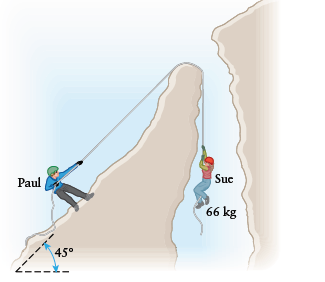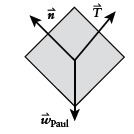
Concept explainers
(a)
The tension in the rope.
Answer to Problem 93QAP
The tension in the rope is
Explanation of Solution
Givendata:
Distance,
Time,
Mass of Sue,
Formula Used:
Newton's second law:
Calculation:

We'll use two different but related coordinate systems for the two people.
For Sue, positive y will point upward.
For Paul, the axes will be parallel and perpendicular to the inclined plane, where up the ramp and out of the ramp are positive.
Tension from the rope pulling up and gravity pulling down are the only forces acting on
Sue.
Assuming her acceleration is constant, we can use the constant acceleration equations
and Newton's second law to calculate the magnitude of the tension.
Sue's acceleration:
Free-body diagram of Sue:

Newton's second law for Sue:
Conclusion:
Thus, from theNewton's second law for Sue we have the tension in the rope joining them as
(b)
Mass of Paul
Answer to Problem 93QAP
Mass of Paul is
Explanation of Solution
Given data:
Distance,
Time,
Mass of Sue,
Formula Used:
Newton's second law:
Calculation:

We'll use two different but relatedcoordinate systems for the two people.
For Sue,positive y will point upward.
For Paul, the axes willbe parallel and perpendicular to the inclined plane,where up the ramp and out of the ramp are positive.
Tension from the rope pulling up and gravity pulling down are the only forces acting on
Sue.
Assuming her acceleration is constant, we can use the constant acceleration equations
and Newton's second law to calculate the magnitude of the tension.
Since Paul and Sue aretethered to one another, the magnitudes of their accelerations are equal.
The tension in therope and gravity are the only forces acting on Paul that have components that are parallel tothe face of the glacier. We can then solve the parallel component of Newton's second law forPaul's mass.
Sue's acceleration:
Free-body diagram of Sue:

Newton's second law for Sue:
Free-body diagram of Paul:

Newton's second law for Paul:
Conclusion:
Thus, by Newton's second law for Paul mass of Paul is
Want to see more full solutions like this?
Chapter 4 Solutions
COLLEGE PHYSICS
- A black widow spider hangs motionless from a web that extends vertically from the ceiling above. If the spider has a mass of 1.5 g, what is the tension in the web?arrow_forwardTwo blocks of unequal mass are connected by a string over a smooth pulley (Figure 2 B). If the coefficient of kinetic friction is μk, what angle θ of the incline allows the masses to move at a constant speed? FIGURE 2-B Problem 2-32.arrow_forwardThe coefficient of friction between a 33kg exercise mat and the gym floor are us = 0.41 and uk = 0.36. Q-Once the mat is moving, what magnitude of horizontal force will keep it moving at a constant velocity?arrow_forward
- A 5.0-kg crate is on an incline that makes an angle 30° with the horizontal. If the coefficient of static friction is 0.5, the maximum force that can be applied parallel to the plane without moving the crate is: (А) 3.3 N (в) 21 N C) 46 N D) 55 Narrow_forwardA man has to push his boat on the shore across the mud to get to the water. The coefficient of friction between the boat and the mud is given by μ = 0.400. If the boat has a mass of 40 kg, calculate the magnitude of the force of friction acting on the boat.arrow_forwardA small vochito of mass 607 kg breaks down as it climbs a hill with an angle of inclination of 17° hel. coefficient of friction between the car and the surface is 0.75. What is the magnitude of its acceleration as it moves down the ramp?arrow_forward
- A 25 kg box is on a 35° hill with a coefficient of friction of 0.1 and an additional applied force pushing upward along the hill on the box with a magnitude of 150 N. Determine its acceleration.arrow_forwardA crate of mass m falls off a truck and initially travels at a speed vo after it hits the ground. Assuming the road is perfectly horizontal, and the coefficient of kinetic friction between the road and the crate is μ, how far down the road will the crate slide before coming to rest?arrow_forwardTwo crates connected by a rope lie on a horizontal surface (see figure below). Crate A has mass mA and crate B has mass mB. The coefficient of kinetic friction between each crate and the surface is uk. The crates are pulled to the right at constant velocity by a horizontal force F. Calculate the magnitude of the force F in terms of mA, mB,& µk t F A Barrow_forward
- An athlete pulls a box E of mass m = 70kg down an incline, as shown. The coefficients of friction between the box and the incline are us-0.40 and uk-0.30. Consider particle analysis of the instant when the force used to pull is 300N. Let 8 = 300 and a = 120. Use the indicated coordinate axes. ala E 0 What is the magnitude of the component of the weight PARALLEL to the incline - i.e., along x-axis?arrow_forwardDuring a military training in Camp Jizmundo, Libas, Banga, Aklan , a sky diver of weighing 82 kg ( including equipment ) falls vertically downward from an altitude of 1500 meters, and opens the parachute after 10 sec of free fall. Assume that the force of air resistance is proportional to velocity. The air drag coefficient before opening the chute is k1 = 1.65 kg/sec , when the parachute is closed and after opening the chute k2 = 26.4 kg/sec.Take g = 9.8 m/s 2 . (a) Find the speed of the sky diver when the parachute opens ? (b) Find the distance fallen before the parachute opens.arrow_forwardThree coplanar forces act on an object P, as illustrated in the Figure, F1=1 with an angle of 52°, F2=51, F3=36. Calculate the force, F4=?. necessary to prevent P from moving.arrow_forward
 Classical Dynamics of Particles and SystemsPhysicsISBN:9780534408961Author:Stephen T. Thornton, Jerry B. MarionPublisher:Cengage Learning
Classical Dynamics of Particles and SystemsPhysicsISBN:9780534408961Author:Stephen T. Thornton, Jerry B. MarionPublisher:Cengage Learning Glencoe Physics: Principles and Problems, Student...PhysicsISBN:9780078807213Author:Paul W. ZitzewitzPublisher:Glencoe/McGraw-Hill
Glencoe Physics: Principles and Problems, Student...PhysicsISBN:9780078807213Author:Paul W. ZitzewitzPublisher:Glencoe/McGraw-Hill Principles of Physics: A Calculus-Based TextPhysicsISBN:9781133104261Author:Raymond A. Serway, John W. JewettPublisher:Cengage Learning
Principles of Physics: A Calculus-Based TextPhysicsISBN:9781133104261Author:Raymond A. Serway, John W. JewettPublisher:Cengage Learning Physics for Scientists and Engineers: Foundations...PhysicsISBN:9781133939146Author:Katz, Debora M.Publisher:Cengage Learning
Physics for Scientists and Engineers: Foundations...PhysicsISBN:9781133939146Author:Katz, Debora M.Publisher:Cengage Learning



